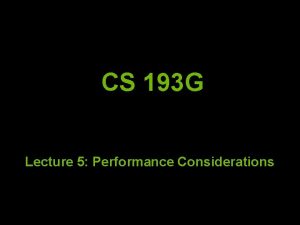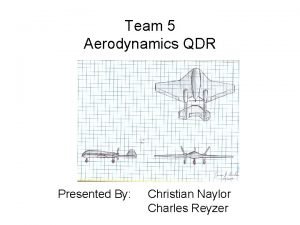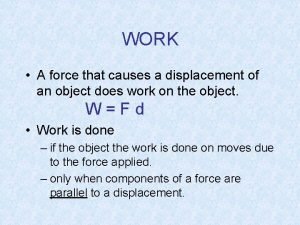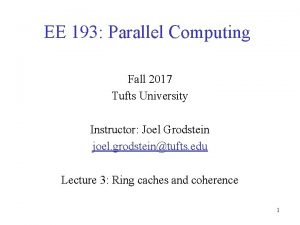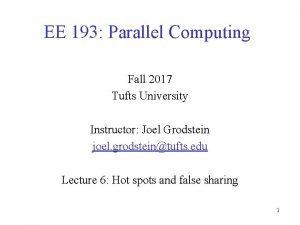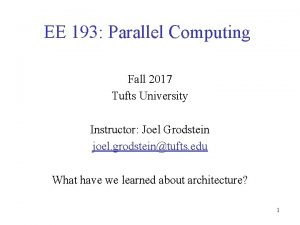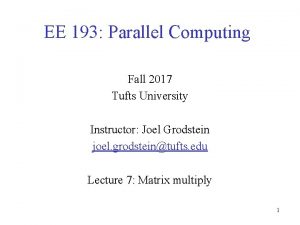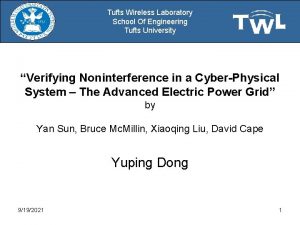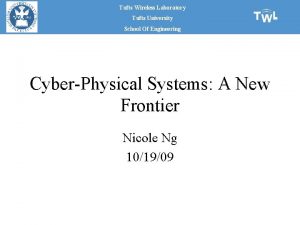EE 193 Parallel Computing Fall 2017 Tufts University


![More pipelining and stalls • Consider a random assembly program load r 2=mem[r 1] More pipelining and stalls • Consider a random assembly program load r 2=mem[r 1]](https://slidetodoc.com/presentation_image_h/01556e75021bb61ba4d28594b984cdbc/image-3.jpg)






- Slides: 9

EE 193: Parallel Computing Fall 2017 Tufts University Instructor: Joel Grodstein joel. grodstein@tufts. edu Simultaneous Multithreading (SMT) 1

Threads • We've talked a lot about threads. • In a 16 -core system, why would you want to have >1 thread? – If you have <16 threads, some of the cores will just be sitting around idle. • Why would you ever want more than 16 threads? – Perhaps you have 100 users on a 16 -core machine, and the O/S rotates them around for fairness – Today we'll talk about another reason EE 193 Joel Grodstein 2
![More pipelining and stalls Consider a random assembly program load r 2memr 1 More pipelining and stalls • Consider a random assembly program load r 2=mem[r 1]](https://slidetodoc.com/presentation_image_h/01556e75021bb61ba4d28594b984cdbc/image-3.jpg)
More pipelining and stalls • Consider a random assembly program load r 2=mem[r 1] add r 5=r 3+r 2 add r 8=r 6+r 7 • The architecture says that instructions are executed in order. – The 2 nd instruction uses the r 2 written by the first instruction EE 194/Comp 140 Mark Hempstead 3

Pipelined instructions Instruction Cycle 1 Cycle 2 Cycle 3 Cycle 4 Cycle 5 Cycle 6 Cycle 7 Cycle 8 load r 2=mem[r 1] fetch add r 5=r 3+r 2 add r 8=r 6+r 7 store mem[r 9]=r 10 read R 1 execute access write r 2 nothing cache fetch read r 3, r 2 add load/st write r 5 r 3, r 2 nothing fetch read r 6, r 7 add load/st write r 8 r 6, r 7 nothing fetch read execute store write r 9, r 10 nothing • Pipelining cheats! It launches instructions before the previous ones finish. • Hazards occur when one computation uses the results of another – it exposes our sleight of hand EE 193 Joel Grodstein 4

Dependence • Pipelining works best when instructions don't use results from just-previous instruction – But instructions in a thread tend to be working together on a common mission; this isn't good • Each thread has its own register file, by definition – They only interact via shared memory or messages – One thread cannot read a register that another thread wrote • Idea: what if we have one core execute many threads? Does that sound at all clever or useful? EE 193 Joel Grodstein 5

Your pipeline, on SMT Instruction Thread Cycle 1 Cycle 2 Cycle 3 Cycle 4 Cycle 5 Cycle 6 Cycle 7 Cycle 8 load r 2=mem[r 1]0 add r 4=r 2+r 3 1 add r 6=r 2+r 7 2 add r 5=r 3+r 2 0 fetch read R 1 execute access write r 2 nothing cache fetch read r 3, r 2 add load/st write r 5 r 3, r 2 nothing fetch read r 6, r 7 add load/st write r 8 r 6, r 7 nothing fetch read execute store write r 2, r 3 nothing • We still have our hazard (from loading r 2 to the final add) • The intervening instructions are not hazards; even though they (coincidentally) use r 2, each thread uses its own r 2. • By the time thread 0 uses r 2, r 2 is in fact ready • No stalls needed EE 193 Joel Grodstein 6

Problems with SMT • SMT is great! Given enough threads, we rarely need to stall • Everyone does it nowadays (Intel calls it hyperthreading) • How many threads should we use? EE 193 Joel Grodstein 7

Your pipeline, on SMT Instruction Thread Cycle 1 Cycle 2 Cycle 3 Cycle 4 Cycle 5 Cycle 6 Cycle 7 Cycle 8 load r 2=mem[r 1]0 add r 4=r 2+r 3 1 add r 6=r 2+r 7 2 add r 5=r 3+r 2 0 fetch read R 1 execute L 1 miss write r 2 nothing fetch read r 3, r 2 add load/st write r 5 r 3, r 2 nothing fetch read r 6, r 7 add load/st write r 8 r 6, r 7 nothing fetch read execute store write r 2, r 3 nothing • What if mem[r 1]is not in the L 1, but in the L 2? It will take more cycles to get the data. But then the final add will have to wait • Could we just stick an extra few instructions from other threads between the load and add, so we don't need the stall? – (Note we've drawn an OOO pipe, where the "add r 4" can finish before the load) EE 193 Joel Grodstein 8

Problems with SMT • Intel, AMD, ARM, etc. , only use 2 -way SMT. There must be a reason… – SMT is great because each thread uses its own regfile – If we have 10 -way SMT, how many regfiles will each core need? – So why don't we do 10 -way SMT? • The mantra of memory: there's no place to fit lots of memory all situated on prime real estate. – Too much SMT → register files become slow – So we're stuck with 2 -way SMT – SMT is perhaps a GPU's biggest trick. It's much more than 2 -way. More on that later • In practice, we don't just alternate threads. We issue instructions from whichever thread isn't stalled. EE 193 Joel Grodstein 9



